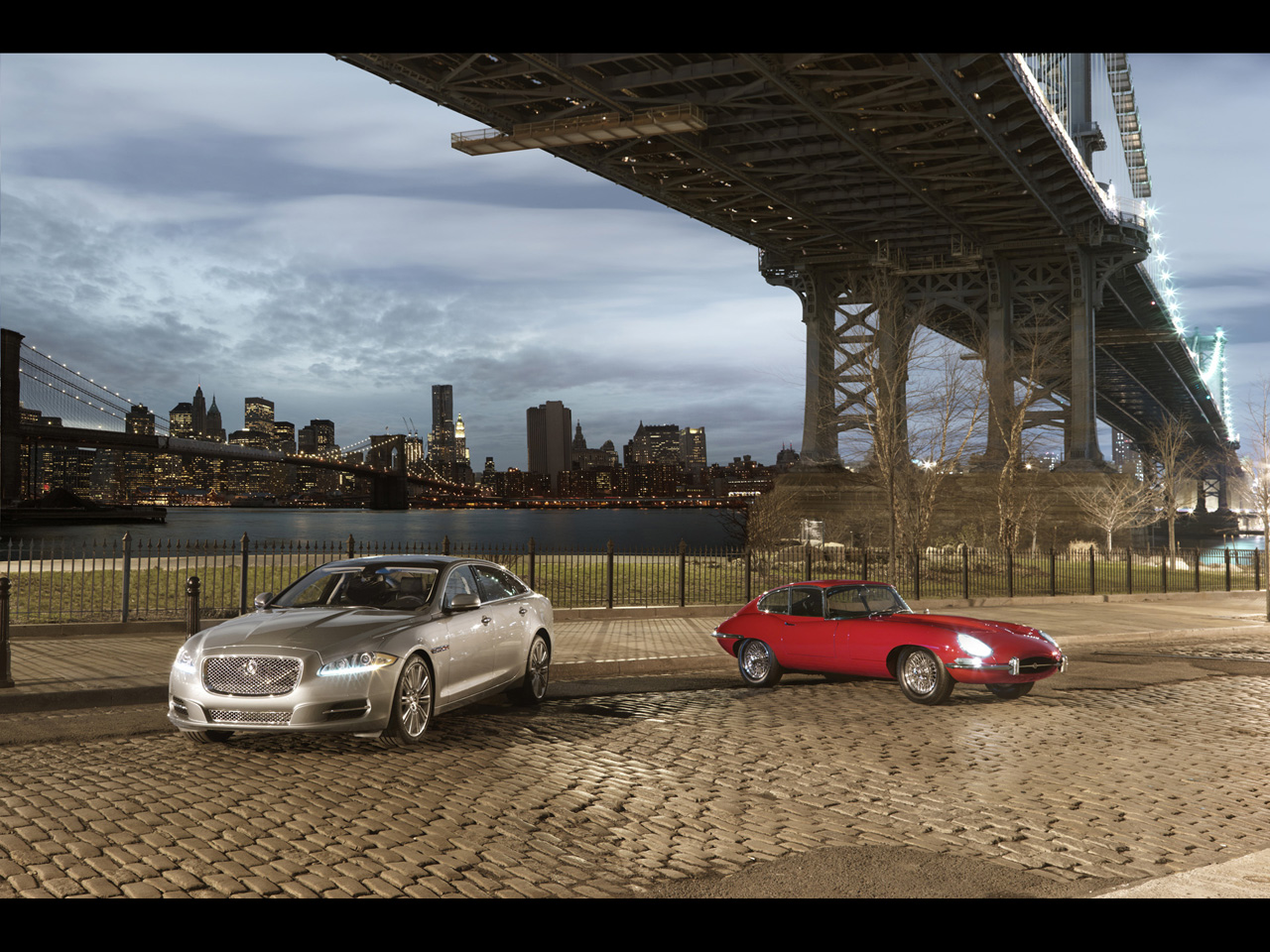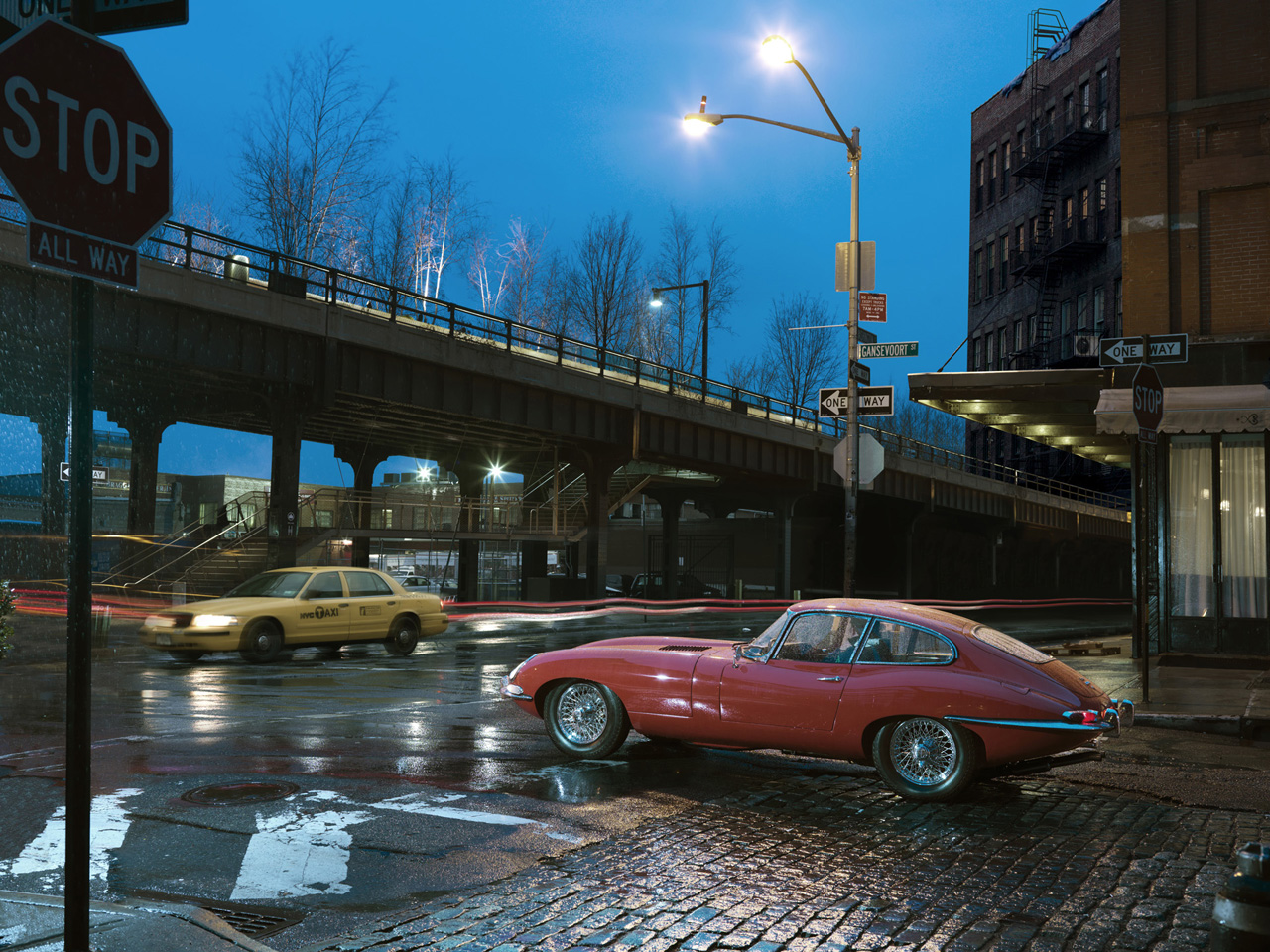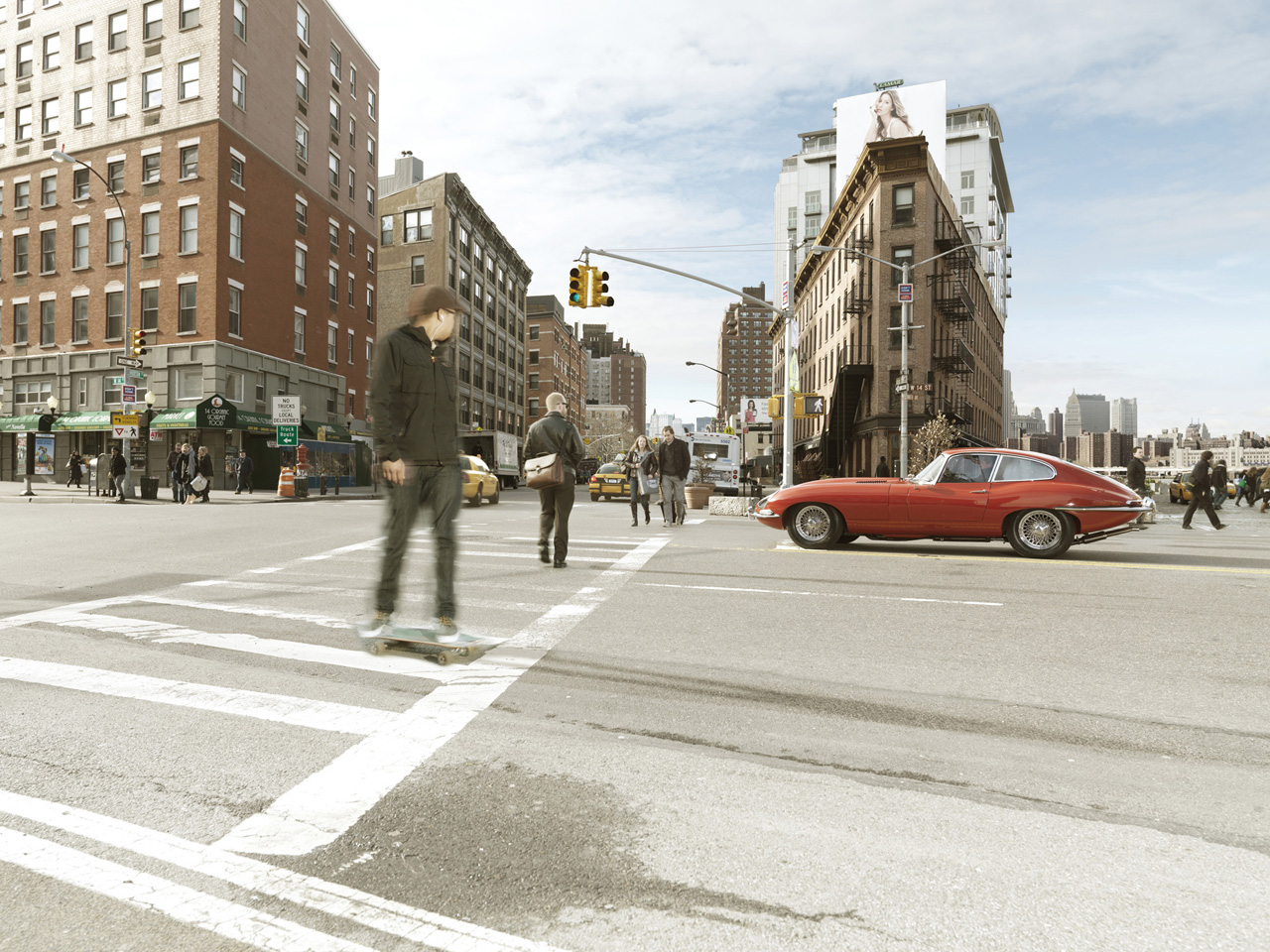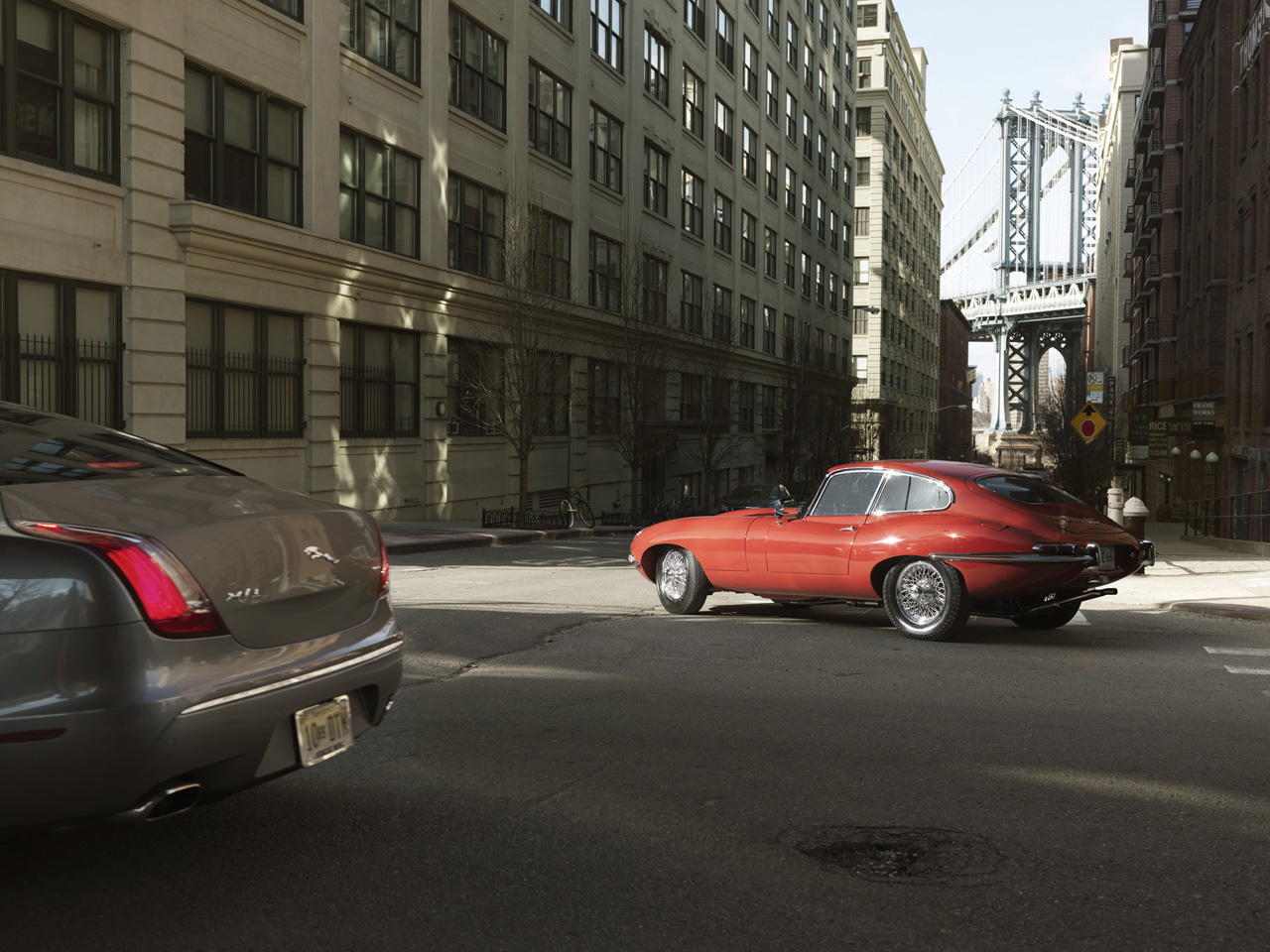1966 Jaguar E-Type Series 1 in New York City
|
Price |
-- |
Production |
-- | ||
|
Engine |
4.2 liter V8 |
Weight |
-- | ||
|
Aspiration |
triple SU carburetors |
Torque |
256 lb-ft @ 4000 rpm | ||
|
HP |
265 hp @ 5500 rpm |
HP/Weight |
-- | ||
|
HP/Liter |
63 hp per liter |
1/4 mile |
-- | ||
|
0-60 mph |
7 seconds |
Top Speed |
151 mph |
(from Jaguar Press Release) E-Type to New XJ: Fifty Years of Design Integrity
Fifty years ago, the New
York Auto Show played host to the launch of an automotive classic:
the Jaguar E-Type - or XKE as it was known in America.
If any country took the E-Type to its heart, it was the United
States. More than two-thirds of all models built were sent across
the Atlantic, establishing a special relationship that persists to
this day.
On first sight of the E-Type at its launch, Frank Sinatra is reputed
to have said: “I want that car and I want it now”, and old Blue Eyes
was just one in a long list of Hollywood greats to covet the
two-seater sports car. Steve McQueen, Tony Curtis, Britt Ekland and
Brigitte Bardot were all celebrity owners.
The beauty, performance and passion that all Jaguars embody still
resonates strongly in America to this day. The 21st century XJ
limousine turns as many heads in New York with its lithe, powerful
and captivating presence as the E-Type did when Sinatra first saw it
50 years ago.
Here, Jaguar’s Design Director Ian Callum explains why:
Two cars, two eras, one company. Both are entirely of their time
but, crucially, both are Jaguars and therefore share a definitive
purpose – to be fast and beautiful.
Few companies are fortunate enough to have the design heritage
enjoyed by Jaguar; one that stretches back half a century and more.
It’s this visual integrity that allows comparisons to be drawn
between the groundbreaking new XJ luxury saloon and the legendary
E-Type sports car, a machine so beautiful that it holds a permanent
place in New York’s Museum of Modern Art. These two cars may be
separated by a gulf of 50 years, during which time the global
automotive industry has changed beyond all recognition, but both are
unmistakeably Jaguars.
Jaguar’s Design Director Ian Callum explains how two cars separated
by more than a generation can share the same design philosophy:
“Part of the purpose of a Jaguar is to look beautiful. We always
tryto make our cars visually that little bit wider, lower and
longer. That’swhat our proportions are about. When you see them
together, the XJ and E-Type speak the same language.”
This is true even though the two cars fulfill very different needs.
One is a high-tech limousine with sporting intent, whose unique
flowing design is conceived to turn heads in the modern world. The
other an iconic two-seater created for the ’60s boy (or girl) about
town.
According to Callum, the E-Type demonstrates the overriding
principle of sports car design: minimum bodywork encapsulating
maximum performance. He explains: “The excitement and beauty of the
car were almost created as a by-product. You’ve got beauty derived
from its scientific purity of surface and excitement from its
proportions.”
“We still work very hard to get the proportions of our cars as tight
to the mechanicals as possible. Unlike the E-Type, of course, the XJ
has to carry five people in total comfort but the principles of
wrapping the body around the package to create exciting proportions
are exactly the same now as they were 50 years ago.”
As envisaged by its designer, Malcolm Sayer, the primary aim of the
E-Type was to be fast. Indeed, topping out at 150mph, it was the
world’s quickest production car.
As an aerodynamicist, Sayer employed a uniquely scientific method of
design, which involved the use of slide rules and logarithmic tables
to plot the complex curves and straight lines that gelled so
harmoniously to create not just the E-Type but its C-Type and D-Type
racing predecessors.
“Malcolm Sayer shaped the E-Type with absolutely pure geometric
lines,” explains Ian Callum. “He wasn’t driven by aesthetics for the
sake of it, he was trying to build something that was shaped by
mathematics. That’s how he built his cars up and their beauty is
determined by purity and simplicity. That same restraint of line
guides us to this day, in everything we do, as we create the next
generation of Jaguars like the XJ.”
The E-Type, however, was more than the epitome of automotive beauty.
It came to symbolise excitement, embodying Jaguar founder Sir
William Lyons’ words that: “driving should be a pleasure not a
chore.”
In its profile, stretched lines, prominent rear haunches and the arc
of the rear window it was the archetype of sporting performance. The
same is true of the XJ, which although it is very much a product of
the 21st century, shares key styling attributes with the E-Type that
have become firmly established in the company’s design language.
Flourishes such as the E-Type’s famous bonnet bulge – necessary to
cover the straight-six engine – have been carried over to the XJ as
a symbol of its potency. Both cars share the same sense of front-end
drama to give that quintessential Jaguar ‘rear-view mirror’
presence.
Callum explains that it was Lyons’ ability to focus on the future
that led to such distinctive designs:
“The E-Type was ahead of its time, just as the XJ is now. Williams
Lyons’ philosophy was all about taking that next step. He was very
adventurous and knew that it is Jaguar’s job to break the rules. He
never looked back, always forward.”
A question Callum is often asked is whether he would design another
E-Type. His answer is always the same: “I would refuse, it had its
time and place. What I will do is create something as dramatic now
as that car was then and I think the XJ achieves that.
“Jaguars should be bought for reasons other than simply pure
pragmatism, they should be bought for their style, excitement and
beauty. The XJ is the most dramatic, captivating car in its class.
Job done.”
Ian Callum, Design Director, Jaguar Cars
Hailed as the architect
of Jaguar’s future success, Design Director Ian Callum has a passion
for the marque that stretches back to his formative years.
Having shown a talent for drawing from the age of four, it was as a
teenager that Callum realised his calling lay in automotive design.
Aged 14, he was inspired by the original XJ saloon, designed by Sir
William Lyons:“That was a car of great proportions and excitement;
it was the best looking and handling saloon in the world at that
time.”
This prompted the youthful Callum to send Bill Heynes, Jaguar’s
engineering guru, some of his own designs. In response Heynes
advised Callum that in order to pursue his dream career, he should
study engineering draughtsmanship and industrial design.
Callum earned a place at the Glasgow School of Art in Scotland,
followed by a Masters degree in Design at the Royal College of Art
in London. After graduating, he designed cars for Ford, Tom
Walkinshaw Racing and Aston Martin. In 1999, a mere 30 years after
seeking Heynes’ advice as a young boy, Callum was appointed Design
Director of Jaguar. He had moved into his dream job.
Callum recognises the huge legacy left in his care by men such as
Lyons, Heynes and Jaguar design legend Malcolm Sayer, insisting that
it is their determination to explore the possibilities of design and
performance that inspires his work today: “I know how intently my
predecessors pushed the boundaries. Jaguar has always been a
forward-thinking company and that philosophy guides us now.”
Despite the ever greater legislative, safety and comfort constraints
on design freedoms, in just over a decade at the helm, Callum has
created an award-winning range of Jaguars that capture the drama and
passion of the cars of old while remaining entirely focused on the
future. As Callum explains: “My task is to look forwards. The car I
am most proud of is the next one.”
The New XJ: A True Jaguar Flagship
Created without
compromise, Jaguar’s flagship XJ limousine is a class-leader in the
mould of Jaguars of old and yet is a beguilingly cutting-edge
offering that places its rivals firmly in the past.
The XJ’s construction is as innovative as its appearance, utilising
state-of-the-art techniques pioneered by Jaguar. Crafted from
high-grade aluminium, the car is lighter than much of its opposition
by up to 150kg with the commensurate gains in performance, agility
and economy. Up to 50 percent of the structure is made from recycled
aluminium allowing for a potential saving of up to 3.3 tonnes of CO2
per car.
In order to maximise the potential of its class-leading
architecture, the XJ is powered by the latest highly-efficient
Jaguar AJ-V8 petrol direct-injection engines, in both naturally
aspirated and supercharged forms. Smooth and powerful, these provide
effortlessly refined performance.
Once inside, passengers will find themselves cocooned in
unparalleled luxury. Bathed in natural light from the panoramic
glass roof, the interior is meticulously crafted from the finest
materials in a manner that is strikingly contemporary.
Standard and long wheelbase versions are available, while new for
the 2012 XJ range is the Rear Seat Comfort package, which offers an
advanced new entertainment system, as well as electric recline,
lumbar adjustment and massage functions.
Jaguar is justly renowned for its innovation and the company has, in
the cockpit of the XJ, created a haven in which cutting-edge
technology is unobtrusively and instantly at the command of the
driver. In place of the traditional instrument panel is a 12.3-inch
high-definition virtual information interface that can be customised
to display a range of driver-critical information.
A unique central 8-inch Touch-screen incorporates exclusive
dual-view technology allowing the front-seat passenger to watch a
DVD while the driver receives satellite navigation information.
A range of premium surround-sound entertainment systems is topped by
the 1200W, 17-speaker system from British experts Bowers & Wilkins
and provides concert-hall levels of audio fidelity. All infotainment
systems feature hard disc-based music storage and connectivity for
audio and video devices via a powerful Media Hub.
Available in three trim levels – Luxury, Premium Luxury and
Portfolio – the Jaguar XJ offers a truly unmatched ownership
experience.
Jaguar E-Type: A Work of Modern Art
The E-Type is still
revered as the ultimate artistic fusion of mechanics and mathematics
and if proof were needed of its aesthetic credentials, it came in
1996 when it was the subject of an exhibition at New York’s Museum
of Modern Art.
Entitled Refining the Sports Car: Jaguar’s E-Type, this was only the
third time a car had been exhibited at the museum and was made
possible by the donation of an opalescent, dark blue 1963 Open Two-Seater
to MOMA by Jaguar.
The exhibition traced the genesis of the E-Type’s design and
engineering from that of the revered 1950s C-Type and D-Type
endurance racers with which it shared a stylist in aerodynamicist
Malcolm Sayer. Alongside the flawless E-Type was an example of its
legendary, race-winning, straight-six engine, images of its
predecessors and original engineering sketches.
The E-Type was one of the first production cars designed along
aerodynamic principles, worked out by Sayer using complex
mathematical equations to design the ellipses and other elements
that defined the car’s timeless appearance.
The organiser of the original exhibition, Assistant Curator of the
Department of Architecture and Design, Christopher Mount said:
“Rarely has a car inspired the kind of passion in both motoring
enthusiasts and the general public that the Jaguar E-type has. Even
today, the E-type is considered an icon of the post-war British
sports car.”
The E-Type was so well received that it is now on permanent display
at MOMA.
1966 SERIES 1 E-TYPE
Top speed: 151mph
0-60mph: 7.0secs
Engine: 3781cc, six-cylinder, in-line; triple SU carburettors
Power/torque: 265bhp @ 5500rpm; 256lb ft @ 4000rpm
Chassis: Steel monocoque, torsion bar and wishbone front
suspension, independent rear suspension
Dimensions: Length 444cm; width 165cm; height 122cm; weight
1219kg.
2012 JAGUAR XJ LWB Supercharged
Top speed: 155mph
(limited)
0-60mph: 4.9secs
Engine: 5000cc, supercharged, 8-cylinder, V-formation
Power/torque: 470bhp @ 6000-6500rpm; 424lb ft @ 2500-5500rpm
Chassis: Aluminium monocoque, wishbones front and rear, Adaptive
Dynamics Dimensions: Length 525cm; width 211cm; height 145cm;
weight 2365kg.



